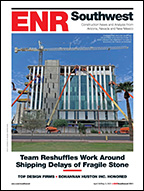In the never-ending war on corrosion, a patented, reinforcing-steel bar certified to last at least 100 years is receiving a second life thanks to venture capitalists hell-bent on improving infrastructure. But it is going up against a heavy tradition of epoxy-coated reinforcing bars, which are constantly on the move in an effort to stay a step ahead of the competition.

Currently made in Wales, the stainless-steel clad rebar emerged in the 1990s as “Stelax,” an alternative to epoxy-coated, galvanized and solid stainless-steel rebar, costing about 25% less than the latter. The product re-emerged in 2006 when a group of investors led by Arkbe Capital Ltd., London, bought the patents and forged NX Infrastructure Ltd.
One thing that attracted the new owners was patent security. “It’s not often you find a small company where people actually have the patents done, says Arkbe CEO Ron Baker. “Usually, they have a great idea, but that’s all.” Baker also liked its potential infrastructure upside.
The concept takes advantage of the corrosion-resistant properties of stainless without the tenfold price premium over plain steel. The rebar comes together when factory workers receive stainless-steel tubes and insert machine-shop turnings sourced from local industries. The plant separates out the industrial oil, recycles it to fuel the reheat furnace, compacts the filings in the tubes, and forms the bar without smelting, consuming up to 40% less energy than usual, the company claims.

The product has already been approved for federal highways designed for a 100-year service life. “In the next five to ten years, we expect to take 5% to 10% of the corrosion-resistant rebar market in the U.S.,” says Pat Harlow, president and chairman of NX and chairman of Con-tech Construction Products Inc. Harlow owns a stake in both suppliers.
States with high chloride concentrations from nearby seawater or road salt are looking at alternatives to epoxy, which often is damaged during construction. “We’ve used epoxy-coated rebar for 20 to 25 years and it has performed well,” explains Michael Sprinkel, associate director of Virginia Transportation Research Center. “But we’re trying to build bridges that are going to last 75 to 100 years. Research we’ve done in the past couple of years indicates that it’s unlikely we are going to get that kind of life out of organically coated bar.” Even so, epoxy suppliers are continually improving, as with Gerdau Ameristeel’s patented “ZBar,” which has a layer of zinc surrounded by a polymer coating.
Although U.S. rebar production dropped 12.5% last year and is expected to fall another 12% this year, rebar-related work stands to gain 2.25 million tons—30% of annual demand—and 12,000 full-time jobs under a President Obama-style stimulus plan, according to Schaumburg, Ill.-based Concrete Reinforcing Steel Institute.
The House version of the stimulus package now contains a “Buy American” provision for steel. Should that pass, projects would need to get a “Buy America” waiver. Timing is everything. NX is set to close on a former automotive plant in Ohio, but executives don’t expect the $100-million factory to start up until the summer of 2010.


